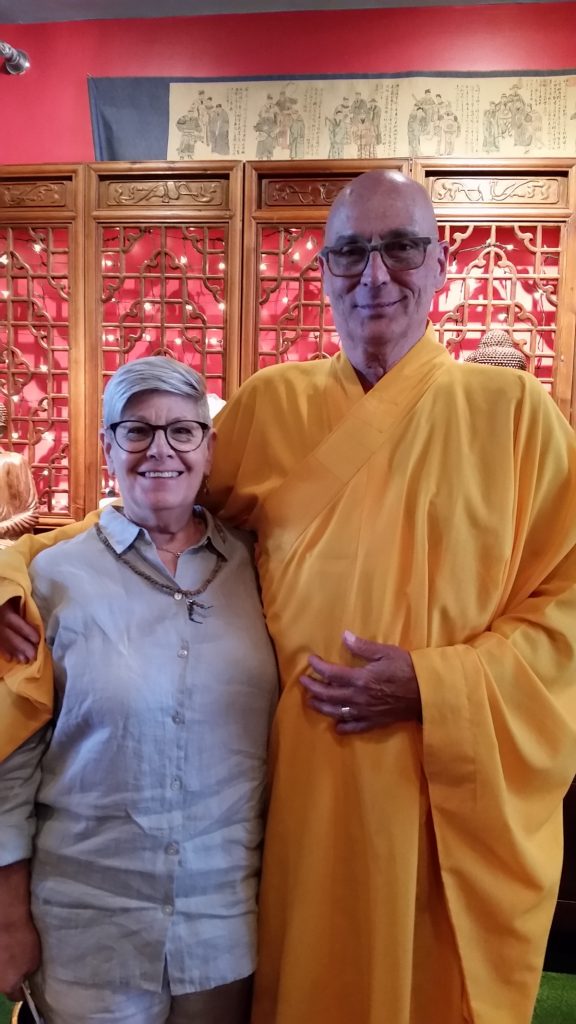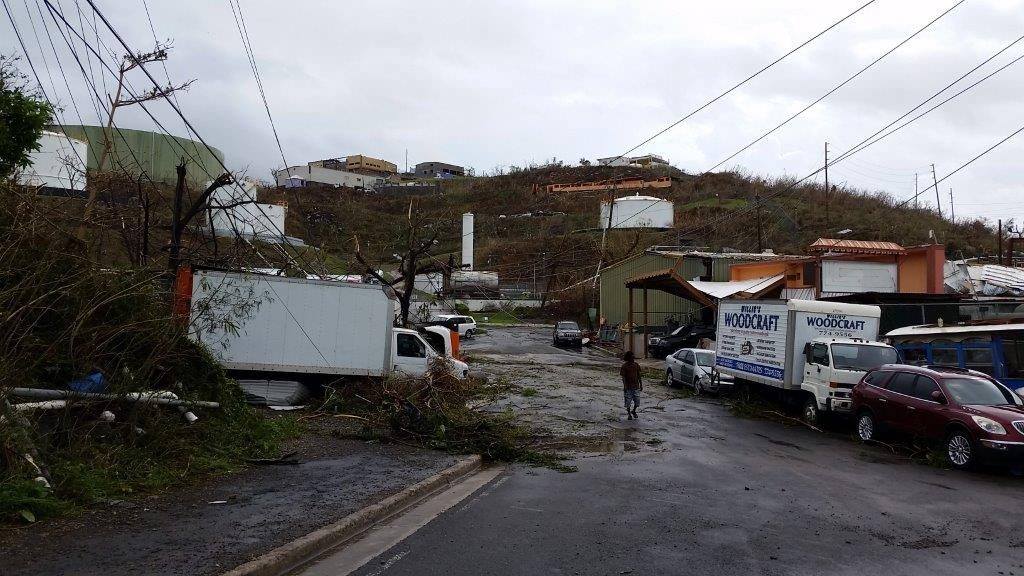As Texas and Louisiana reeled from Hurricane Harvey, and as Hurricane Irma set her sights on the Caribbean, Lisa Droski packed her bags.
Droski, a Buddhist practitioner who lives in Grand Rapids, Michigan, is a retired registered nurse and current volunteer with the American Red Cross.
Shortly after arriving in the U.S. Virgin Island of St. Croix by way of San Juan and Houston, Droski hopped a military transport to St. Thomas, where her medical expertise was desperately needed after Hurricane Irma made landfall in early September. She was on the island when Hurricane Maria came two weeks later.
Two category five hurricanes hit the U.S. Virgin Islands last month, knocking out the power grid and leaving residents without electricity, water, food, and access to essentials. The chain of islands, situated about 40 miles east of Puerto Rico, are home to about 106,000 people.
Droski spoke with Tricycle shortly after returning to the continental U.S. about the conditions in the Virgin Islands, the work that still needs to be done, and how her practice helped her endure three weeks of service.

How did you end up doing volunteer work on St. Thomas?
I’ve been a nurse with the Red Cross Disaster Health Services for many years. I’m on the national team, so I usually respond to large-scale disasters.
I had been asked to go to Hurricane Harvey, but I was out of the country at the time. When Irma came, I was home, and my local Red Cross chapter called and asked if I could volunteer. I said “certainly.” They had first planned to send me to Florida, and then they asked me to go to St. Croix in the Virgin Islands. I was on St. Croix for about five minutes before they sent me to St. Thomas on a passenger jet chartered by the military.
When we landed, I was taken to the Red Cross headquarters in an office building. I was the only Disaster Health Services person across three islands when I got there, so they made me the head of the Disaster Health Services. I was my own boss.
Within 24 hours a lot of other relief workers came in. I worked with a very talented EMT, as well as people from disaster mental health services, and we started working in the largest local shelter on St. Thomas, which had been run by the local Red Cross and the Department of Human Services on St. Thomas since before Irma. There were close to 200 people in the shelter.
What were the conditions in St. Thomas like?
There was a curfew from 10 p.m. to 6 a.m. every day, and there was no cell phone communication. I had absolutely no Internet, like most people. The stores that were open had really long lines. ATMs and all those kinds of daily things that people have gotten used to weren’t working.
When it started to seem like conditions were improving a little bit, Hurricane Maria came. About half of the Red Cross folks on St. Thomas went home, because we were told in no uncertain terms that if we stayed, we might not have food and water. Many people elected to go home, or left because their families wanted them home.
About 30 of us stayed on the island, and I was assigned to an evacuation shelter in a middle school. We took care of about 130 people in two rooms over four days. We had the support of the Puerto Rico National Guard members, who were there even when their own families and homes were taking a direct hit.
The logistics of getting aid to people is really daunting. Everything has to come in by barge. There were boats sunk in the harbor, and there were landslides. Even driving a minivan was dangerous, because there was still debris on some of the roads—you could go around a blind curve and find a broken telephone pole with miles of downed wire. We had numerous flat tires. You just can’t get around.
Why did you decide to stay for the second storm? What did you weigh in your decision?
I thought, “OK, these folks have been through a category five hurricane already and they survived, and the building I’m going to be in seems pretty sturdy. I came here to help people, and me leaving now is not helping anybody.” I discussed this with my husband, who was a little nervous. I was a little nervous, too—you’d have to be silly not to be nervous—but I wasn’t frightened. I felt that I needed to fulfill the mission that I went there to do.
What kind of care did you administer?
It was mostly mental health needs and helping people who needed medication that they couldn’t get otherwise.
People had been traumatized. The staff was nervous and the National Guard members were worried about their families, so most of what I did was just listening—mental health first-aid things.
After Maria, I was assigned to a shelter with about 30 elderly and special needs clients who needed a lot of care and probably should have been in nursing homes. We did basic care for these folks; bathing them, changing diapers, bandaging wounds. That’s not usually what the Red Cross does, but that’s what we did.
When we hear about hurricanes and other natural disasters, the emphasis is on the number of lives lost and physical damage to property. We don’t often hear about the damage a storm can do in terms of mental health.
Mental health is really overlooked. Staff members get burned out, stressed, tired; they want to go home. So we did a lot of counseling with the staff and shelter folks.
And I learned that mental health is still a stigma on the islands. According to family physicians we spoke to, there is only one psychiatrist on St. Thomas, who is in his 80s and has pretty much retired. He doesn’t prescribe medication and did not practice at all when we were there. Most of the primary care physicians are uncomfortable prescribing psychiatric meds. So there are a lot of people with mental illness who are not treated, and everything becomes exacerbated when you add stress on top.
When did you decide it was time to go home?
I went home because my three weeks were up. I was ready. It was hot and humid and we were living in very Spartan conditions. We had a couple of friendly tarantulas that kept visiting us. I really wanted a bed, shower, and clean clothes.
Can you tell me a little bit about your Buddhist practice and community?
I am a sangha member of the Grand Rapids Buddhist Temple and have been an on-and-off solo Buddhist practitioner since the late 1970s. When I started practicing, I didn’t know that there was an English-speaking Buddhist temple in Grand Rapids. I started going to that temple a couple of years ago, and found it to be a very warm, welcoming teaching community where I immediately felt accepted. Last June I got the gifts of the precepts, and I really felt the support of the sangha.
The new abbot of our sangha is Ai Su Kimberly Hillebrand, and she wrote me a metta [lovingkindness] meditation mantra to take with me. I kept it in a locket and recited it every morning and evening. It helped keep me grounded, and reminded me to use mindfulness to focus on what I was doing at the moment without worrying about what was going on around me, even when everyone was calling “Nurse, nurse, nurse.” Practicing equanimity was the hardest thing, because I saw a lot that I wanted to change.
Are there any lessons from your time in St. Thomas that you’ll carry with you from this experience?
I think we all found community. The Red Crossers who were there became like family, because we had a common purpose.
The people of St. Thomas were very appreciative of us being there and let us know that in many ways. There was a Wendy’s and a Kmart on St. Thomas that were open, and they had a special line for first responders and emergency workers so we could get into the store more quickly. If we needed prescriptions filled, they always let us to the front of the line at the drug stores.
Do you think your Buddhist practice draws you to service?
I felt drawn to help people before, but I think my Buddhist practice made it easier for me to understand the interconnectedness of all people and things. I wasn’t able to do any formal sitting meditation when I was there, but every night right before lights out I would chant the White Tara mantra, which really helped me focus on compassion, and then I would sit or lie on my cot and try to meditate for a little while. I’m calmer and more in tune with other people than when I went to Katrina, particularly, and Sandy, and I have some guiding teachings to keep me focused. And I think it’s really important for us to know as Buddhists that there are practical ways that we can put our Buddhism into action.
Thank you for subscribing to Tricycle! As a nonprofit, we depend on readers like you to keep Buddhist teachings and practices widely available.
